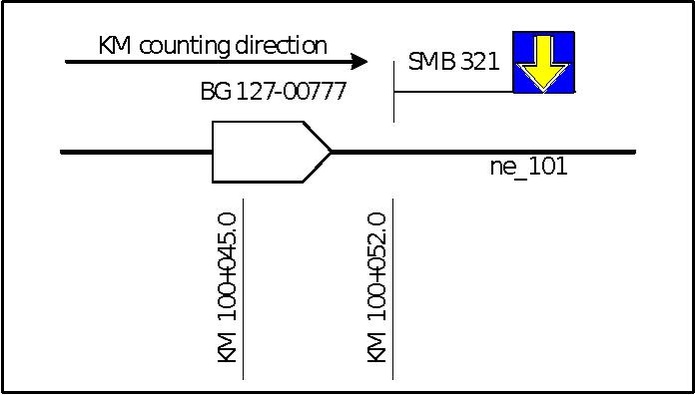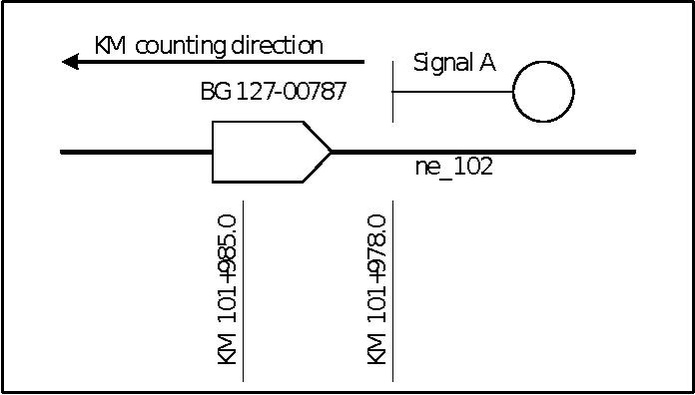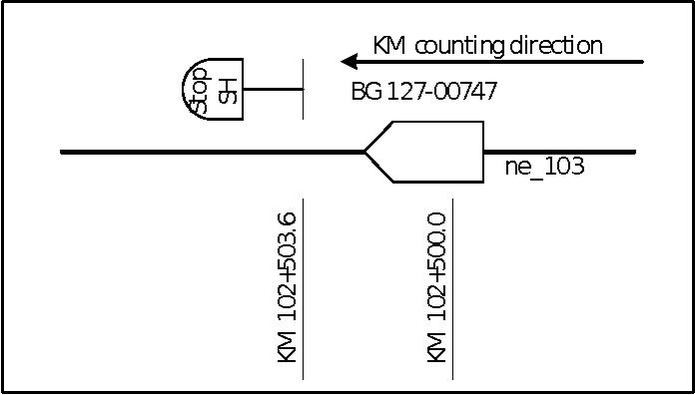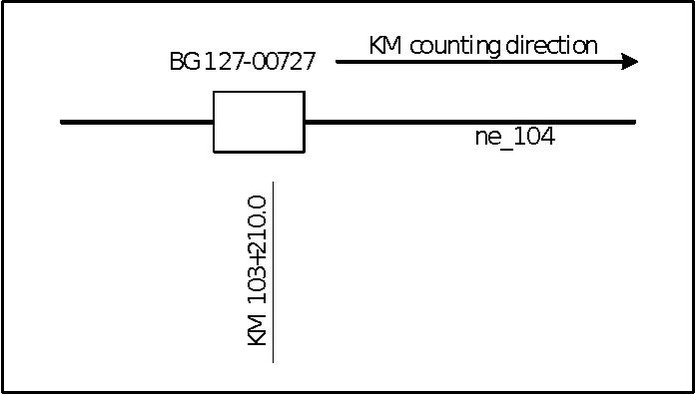User:RailML Coord Documentation/IS:baliseGroup
Introduction
Automatic train protection systems (ATP systems) consist of an onboard system part and a trackside system part. The communication between trackside and onboard equipment is realized in various different technical solutions using different media like cables (for example ATP system LZB in Germany), inductive systems (for example ATP system PZB in Germany), balises (like ATP system EBICAB in Norway) or others.
To provide information particular about balise based ATP systems, the railML® element <baliseGroup> shall be used. However for ATP systems using other media (cable, inductive, mechanical, ….), the optional railML® element <trainProtectionElement> and their child elements shall be used.
General attributes suitable for a balise group
The railML® element railML/infrastructure/functionalInfrastructure/baliseGroups/baliseGroup can be used for every kind of a balise group.
This means concerning the hardware aspect, that the railML® element <baliseGroup> can be used to describe a KVB balise group, an Ebicab balise group or and RSDD balise group (usually known as KER balise systems), and of course also for a Eurobalise group with their software applications like GNT, ZBS, specific packet 44 applications (e.g. like TBL1+) or – most common – for ETCS.
For all these various balise based ATP systems the general information below can be described with railML®:
- the Location of the balise group (which is the location of the first balise of the balise group)
→see child <spotLocation> - the number of balises belonging to the considered balise group
→see @numberOfBalisesInGroup - the orientation of the balise group in relation to the netElement
→see @mileageDirection - information, if the balise group is covered (virtually or physically as e.g. by a metal plate which suppressed the transmission of information from the balise group)
→see @coverage - information of the balise group application, which can be a specific packet 44 application or ETCS or others
→see sub-element <applicationType>
In case of <applicationType>@value="ETCS", the optional sub-element <isEurobaliseGroup> shall be used to specify the information required for ETCS.
Information of the balise group function
To equip a railway line with a balise based ATP system, often the balise group locations and their functions are determined during the design phase.
The railML® element <baliseGroup> can describe balise group functions as below:
- a relation to other elements located lateral at the track
→see child <connectedWithInfrastructureElement> - the functional type depending on the balise group orientation (nominal or reverse)
→see child <functionalType> - the name(s) of the balise based ATP system application(s)
→see child <applicationType>
The balise group functions, the track topology information and the infrastructure manager specific ATP operational rules are the basis to determine the ATP trackside equipment and if necessary also the software of the ATP elements (like for ETCS).
According to the use case ETCS Track Net, the railML® element <baliseGroup> provides the attributes and elements to transfer the information of the design phase from an infrastructure manager to a signaling supplier via railML®.
Specific Information for an Eurobalise group for ETCS
In case if a balise group is an Eurobalise group, then the railML® child element <isEurobaliseGroup> can be used to provide ETCS specific balise group information.
This is applicable for all ATP systems using a hardware device fulfilling UNISIG-SUBSET-036 (Specification of Eurobalise) together with an SRS ETCS based telegram language as for GNT, ZBS, ETCS or national ATP applications using ETCS-Packet 44.
- Relation between railML® attributes and the corresponding UNISIG variables for ETCS
In case of a Eurobalise group, the optional sub-element <isEurobaliseGroup> shall be used to specify the ETCS related information:
- the value of UNISIG variable M_VERSION valid for all balises belonging to the considered balise group (provided in railML® by attribute @mVersion), which is defined by UNISIG in SUBSET-026 (versions 2.3.0, 3.4.0 or 3.6.0), section 7.5.1.79
- the value of UNISIG variable NID_C (provided in railML® by attribute @countryID), which is defined by UNISIG in SUBSET-026 (versions 2.3.0, 3.4.0 or 3.6.0), section 7.5.1.86
- the value of UNISIG variable NID_BG (provided in railML® by attribute @groupID), which is defined by UNISIG in SUBSET-026 (versions 2.3.0, 3.4.0 or 3.6.0), section 7.5.1.85
- the value of UNISIG variable N_TOTAL (provided in railML® by attribute @numberOfBalisesInGroup; N_TOTAL = [value of numberOfBalisesInGroup]-1), which is defined by UNISIG in SUBSET-026 (versions 2.3.0, 3.4.0 or 3.6.0), section 7.5.1.82
- the value of UNISIG variable Q_LINK (provided in railML® by attribute @isLinked), which is defined by UNISIG in SUBSET-026 (versions 2.3.0, 3.4.0 or 3.6.0), section 7.5.1.114
- the value of UNISIG variable Q_LOCACC (provided in railML® by attribute @locationAccuracy), which is defined by UNISIG in SUBSET-026 (versions 2.3.0, 3.4.0 or 3.6.0), section 7.5.1.115
- the value of UNISIG variable Q_LINKREACTION (provided in railML® for train movements passing the balise group in nominal direction by attribute @linkReactionNominal; provided in railML® for train movements passing the balise group in reverse direction by attribute @linkReactionReverse), which is defined by UNISIG in SUBSET-026 (versions 2.3.0, 3.4.0 or 3.6.0), section 7.5.1.117
- Remarks
- If a balise group shall be covered during a construction phase, then it is possible to specify if the coverage is executed physically by a metal plate (@coverage="physical") or if the coverage is managed virtually using ETCS packet 0 (@coverage="virtual"). The optional railML® element '<isValid from="" to=""/> can be used to specify the period during which the balise group is to be covered.
- The values of the following UNISIG variables of the ETCS balise telegram header are implicitly provided if a railML® element baliseGroup is used:
- Q_UPDOWN=1 (means: “Up-link telegram: track to train)
- Q_MEDIA=0 (means: “Balise”)
- The values of the following UNISIG variables of the ETCS balise telegram header can be provided by the railML® element balise (see section 2), if necessary:
- M_DUP
- N_PIG
- In case of ATP systems “GNT” and “ZBS”, @mVersion="0" shall be used. Further optional railML® attributes describing UNISIG variables can be used if appropriate.
Examples
Example 1 – Balise group with SMB (ETCS Level 2)
Example 1 – Balise group with SMB (ETCS Level 2)
- Explanation
A balise group is assigned to a stop marker board (SMB) 321 (ID inside the railML®: @ref="sig_SMB_321"). The balise group is oriented in direction of increasing mileage (@mileageDirection="nominal") and in consequence the internal numbering of the balises in the balise group is aligned with the increasing mileage.
The balise group has only a logical connection (@type="logical") with the real signal / SMB on the trackside. The balises in this balise group are not covered virtually (@coverage="none").
The balise group consists of two balises (@numberOfBalisesInGroup="2") used for ETCS (applicationType value="ETCS"), which are allocated in Germany (@countryID="127" means Germany). It is the balise group No. 777 in Germany (@groupID="777").
The balise group is announced by a linking information (@isLinked="true") transmitted to the train. If a train running in the direction of increasing mileage will not detect the balise group within the expectation window, then the ETCS onboard system will trigger a trip procedure immediately (@linkReactionNominal="trainTrip"). If a train running in the direction of decreasing mileage will not detect the balise group within the expectation window, then the ETCS onboard system will ignore this problem (@linkReactionReverse="noReaction").
The additional tolerance value on the regular accuracy towards the measured location is +/- 5m (@locationAccuracy="5"). UNISIG-baseline 3 is in use (@mVersion="32").
- Corresponding railML® description
<baliseGroups>
<baliseGroup id="bg1" mileageDirection="nominal" coverage="none"
numberOfBalisesInGroup="2">
<name name="127-00777" description="etcsName" language="EN"/>
<spotLocation id="bg1_sloc01" netElementRef="ne_101"
applicationDirection="both" pos="45.0">
<linearCoordinate positioningSystemRef="lps01" measure="100045.0" />
</spotLocation>
<applicationType value="ETCS" />
<connectedWithInfrastructureElement ref="sig_SMB_321" type="logical" />
<functionalType value="signal" mileageDirection="nominal" />
<isEurobaliseGroup countryID="127" groupID="777" isLinked="true"
linkReactionNominal="trainTrip" linkReactionReverse="noReaction"
locationAccuracy="5" mVersion="32" />
</baliseGroup>
</baliseGroups>
Example 2 – Balise group with main signal (ETCS Level 1)
Example 2 – Balise group with main signal (ETCS Level 1)
- Explanation
A balise group is assigned to a signal “Signal A” (ID inside the railML® file: @ref="sig_A"), which is oriented in direction of decreasing mileage. The balise group is oriented in direction of decreasing mileage (@mileageDirection="reverse") and in consequence the internal numbering of the balises in the balise group is aligned with the decreasing mileage.
The balise group has a physical connection (@type="physical") with the real signal on the trackside. The balises in this balise group are not covered virtually (@coverage="none").
The balise group consists of two balises (@numberOfBalisesInGroup="2") used for ETCS (<applicationType value="ETCS"), which are allocated in Germany (@countryID="127" means Germany). It is the balise group No. 787 in Germany (@groupID="787").
The balise group is announced by a linking information (@isLinked="true") transmitted to the train. If a train running in the direction of decreasing mileage will not detect the balise group within the expectation window, then the ETCS onboard system will trigger a trip procedure immediately (@linkReactionNominal="trainTrip"). If a train running in the direction of increasing mileage will not detect the balise group within the expectation window, then the ETCS onboard system will ignore this problem (@linkReactionReverse="noReaction").
The additional tolerance value on the regular accuracy towards the measured location is +/- 5m (@locationAccuracy="5"). UNISIG-baseline 2 is in use (@mVersion="16").
- Corresponding railML® description
<baliseGroups>
<baliseGroup id="bg2" mileageDirection="reverse" coverage="none"
numberOfBalisesInGroup="2">
<name name="127-00787" description="etcsName" language="EN"/>
<spotLocation id="bg2_sloc01" netElementRef="ne_102"
applicationDirection="both" pos="985.0">
<linearCoordinate positioningSystemRef="lps01" measure="101985.0"/>
</spotLocation>
<applicationType value="ETCS"/>
<connectedWithInfrastructureElement ref="sig_A" type="physical"/>
<functionalType value="signal" mileageDirection="reverse"/>
<isEurobaliseGroup countryID="127" groupID="787" isLinked="true"
linkReactionNominal="trainTrip" linkReactionReverse="noReaction"
locationAccuracy="5" mVersion="16"/>
</baliseGroup>
<baliseGroups/>
Example 3 – Balise group for a stop-if-in-shunting panel (ETCS Level 1 and/or 2)
Example 3 – Balise group for a stop-if-in-shunting panel (ETCS Level 1 and/or 2)
- Explanation
A balise group is assigned to a stop-if-in-shunting panel (ID inside the railML® file: @ref="panel_StopSH"). The balise group is oriented in direction of increasing mileage (@mileageDirection="nominal") and in consequence the internal numbering of the balises in the balise group is aligned with the increasing mileage.
The balise group has only a logical connection (@type="logical") with the real stop-if-in-shunting panel on the trackside. The balises in this balise group are not covered virtually (@coverage="none").
The balise group consists of two balises (@numberOfBalisesInGroup="2") used for ETCS (applicationType value="ETCS"), which are allocated in Germany (@countryID="127" means Germany). It is the balise group No. 747 in Germany (@groupID="747").
The balise group is announced by a linking information (@isLinked="true") transmitted to the train. If a train running in the direction of increasing mileage will not detect the balise group within the expectation window, then the ETCS onboard system will ignore this problem (@linkReactionNominal="noReaction"). If a train running in the direction of decreasing mileage will not detect the balise group within the expectation window, then the ETCS onboard system will ignore this problem (@|linkReactionReverse|IS:isEurobaliseGroup}}="noReaction"), too.
The additional tolerance value on the regular accuracy towards the measured location is +/- 5m (@locationAccuracy="5"). UNISIG-baseline 2 is in use (@mVersion="16").
- Corresponding railML® description
<baliseGroups>
<baliseGroup id="bg3" mileageDirection="nominal" coverage="none"
numberOfBalisesInGroup="2">
<name name="127-00747" description="etcsName" language="EN"/>
<spotLocation id="bg3_sloc01" netElementRef="ne_103"
applicationDirection="both" pos="500.0">
<linearCoordinate positioningSystemRef="lps01" measure="102500.0"/>
</spotLocation>
<applicationType value="ETCS"/>
<connectedWithInfrastructureElement ref="panel_StopSH" type="logical"/>
<functionalType value="stopIfInShunting" mileageDirection="nominal"/>
<isEurobaliseGroup countryID="127" groupID="747" isLinked="true"
linkReactionNominal="noReaction" linkReactionReverse="noReaction"
locationAccuracy="5" mVersion="16"/>
</baliseGroup>
<baliseGroups/>
Example 4 – Balise group for odometry purposes (ETCS Level 1 and/or 2)
Example 4 – Balise group for odometry purposes (ETCS Level 1 and/or 2)
- Explanation
This example shows a balise group for the odometry correction along a track. The internal orientation of the balise group is in direction of increasing mileage (@mileageDirection="nominal").
The balise group consists of one balise (@numberOfBalisesInGroup="1") used for ETCS (<applicationType value="ETCS"), which is allocated in Germany (@countryID="127" means Germany). It is the balise group No. 727 in Germany (@groupID="727"). The balise in this balise group is not covered virtually (@coverage="none").
The balise group is announced by a linking information (@isLinked="true") transmitted to the train. If a train running in the direction of increasing mileage will not detect the balise group within the expectation window, then the ETCS onboard system will ignore this problem (@linkReactionNominal="noReaction"). If a train running in the direction of decreasing mileage will not detect the balise group within the expectation window, then the ETCS onboard system will ignore this problem (@linkReactionReverse="noReaction"), too. The additional tolerance value on the regular accuracy towards the measured location is +/- 5m (@locationAccuracy="5"). UNISIG-baseline 2 is in use (@mVersion="16").
- Corresponding railML® description
<baliseGroups>
<baliseGroup id="bg4" mileageDirection="nominal" coverage="none"
numberOfBalisesInGroup="1">
<name name="127-00727" description="etcsName" language="EN"/>
<spotLocation id="bg4_sloc01" netElementRef="ne_104"
applicationDirection="both" pos="210.0">
<linearCoordinate positioningSystemRef="lps01" measure="103210.0"/>
</spotLocation>
<applicationType value="ETCS"/>
<functionalType value="odometry" mileageDirection="nominal"/>
<isEurobaliseGroup countryID="127" groupID="727" isLinked="true"
linkReactionNominal="noReaction" linkReactionReverse="noReaction"
locationAccuracy="5" mVersion="16"/>
</baliseGroup>
<baliseGroups/>
Example 5 – Balise group for Temporary Speed Restrictions [TSR] (ETCS Level 1 and/or 2)
Example 5 – Balise group to announce a Temporary Speed Restriction [TSR] (ETCS Level 1 and/or 2)
- Explanation
This example shows a temporary balise (<isValid from="2022-06-01" to="2022-07-15"/>) group in approach of a zone with temporary speed restriction [TSR], for example due to track work. The internal orientation of the balise group is in direction of increasing mileage (@mileageDirection="nominal").
The balise group consists of 4 balises (@numberOfBalisesInGroup="4") used for ETCS (<applicationType value="ETCS"), which is allocated in Germany (@countryID="127" means Germany). It is the balise group No. 8003 in Germany (@groupID="8003").
The <balise> in this balise group is not covered virtually (@coverage="none"). The balise group is marked as an unlinked balise group (@isLinked="false") and therefore without linking properties (means, no use of the optional attributes @linkReactionNominal, @linkReactionReverse and @locationAccuracy). UNISIG-baseline 2 is in use (@mVersion="16").
- Corresponding railML® description
<baliseGroups>
<baliseGroup id="bg5" mileageDirection="nominal" coverage="none"
numberOfBalisesInGroup="4">
<name name="127-08003" description="etcsName" language="EN"/>
<isValid from="2022-06-01" to="2022-07-15"/>
<spotLocation id="bg5_sloc01" netElementRef="ne_105"
applicationDirection="both" pos="650.0">
<linearCoordinate positioningSystemRef="lps01" measure="104650.0"/>
</spotLocation>
<applicationType value="ETCS"/>
<functionalType value="TSR" mileageDirection="nominal"/>
<isEurobaliseGroup countryID="127" groupID="8003" isLinked="false"
mVersion="16"/>
</baliseGroup>
<baliseGroups/>
Additional Information
Open Issues
If the general information provided by the railML® element “baliseGroup” is not sufficient for a KER balise application, then please open a request in the railML® forum – https://forum.railml.org (link to the railML® website) – reporting the missing information to be modelled in railML®. railML®.org will provide a suggestion for modelling the missing information in railML®, for example added by a new optional sub-element railML/infrastructure/functionalInfrastructure/baliseGroups/baliseGroup/isEbicabBalise which includes the new requested information.
Semantic Rules applicable for railML® element “baliseGroup”
The following semantic rules are applicable for the use of element <baliseGroup> with railML® 3.2:
|
Justification: According to UNISIG-026 (versions 2.3.0, 3.4.0 or 3.6.0), section 3.4.2.2.1 and UNISIG-040 (versions 2.3.0, 3.3.0 or 3.4.0) section 3.3.1.3, a balise group (represented by the railML® element <baliseGroup>) shall be considered as point-shaped element without extension. The reference location of the balise group is the location of the balise with N_PIG=0.



